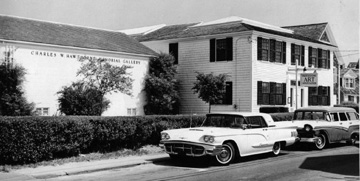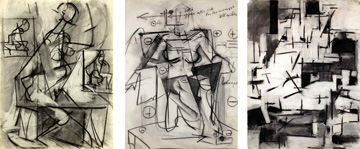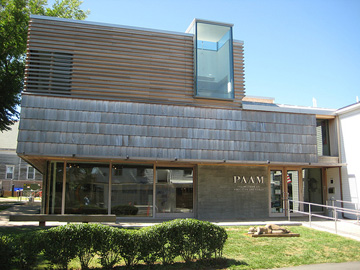I admit to being surprised at the role the visual arts plays in Provincetown, Massachusetts. In college, I remember learning about Hans Hofmann’s famous school, which taught artists (Helen Frankenthaler, Allan Kaprow, Larry Rivers, Lee Krasner, etc.) about modern art. This once sleepy fishing town, it turns out, wasn’t only an important center for American theatre and art during the middle of the 20th C. but it continues to retain that role even as it transform into a very contemporary community. At the center of this change is a rather superb small museum, the Province Art Association & Museum (aka PAAM).
Last weekend, I traveled to this small town of less than 4,000 year-round residents and met PAAM’s Executive Director, Christine M. McCarthy, to find out more about the town’s fine arts soul. She was friendly, welcoming and exuberant about what has been achieved in Provincetown. “You can’t find more culture in 3 square miles anywhere else,” she offered as evidence of Provincetown’s role as cultural mecca.

Charles W. Hawthorne "His First Voyage" (1915). Gift of Joseph Hawthorne, Coll. PAAM
When I visited, PAAM was hosting five (mostly one-room) exhibitions, including a permanent collection display dominated by works by founding art colony father Charles W. Hawthorne and his ilk, a show of drawings by Hans Hofmann’s students (which included 15 drawings loaned by the Metropolitan Museum of Art), a retrospective of assemblage artist Varujan Boghosian, Anne Peretz’s paintings of Cape Cod, and a fundraising show featuring work by PAAM members. It seemed like an incredible number for such a small museum.
McCarthy talked about the revolution that has been happening in the visual arts in Provincetown, which is unique not only for its location at the scenic tip of Cape Cod but also for its large LGBT population, which explains the prominent rainbow flags that hang on its main thoroughfare, Commercial Street.
Before PAAM, McCarthy worked at the ICA in Boston and played a role in that institution’s renovation. A friend brought to her attention that the PAAM was looking for a director and then egged her on to apply. When she arrived in P-town, as Provincetown is often known, she was confronted with an old mansion-like building that leaked and couldn’t properly display its own collection.

PAAM a few decades ago, Photo courtesy paam.org
Since her arrival, McCarthy has helped to develop PAAMs relationship with other cultural institutions in the region, including the Norman Mailer and Tennessee Williams Festivals, and has grown the institution’s budget by three times by soliciting donations from not only longtime residents but also from those that seasoned there. “70% of Provincetown is second homes and no one had ever asked these people to donate,” she said about a coup that resulted in fundraising events in New York and Boston to reach those people who also loved P-town’s unique cultural role.
In the end, 600 people donated anywhere from $5 to $500,000 to PAAM’s capital campaign and P-town become home to the country’s first green museum. It is an amazing feat created without any local government money and a lot of opposition from members of the community who forced McCarthy to attend endless town halls to make her case. PAAM received a major helping hand from the US Dept. of Agriculture (USDA), since P-town is classified as a rural community, but most of the work involved creating a new network of donors to supplement the current one.
Since its transformation, PAAM membership has grown exponentially and promised gifts have increased ten fold, according to McCarthy. PAAM’s collection now includes works by Alex Katz, Any Warhol, Hans Hofmann, Robert de Niro, Sr., Jack Tworkov, Adolph Gottlieb, Milton Avery, and others.
As the centerpiece of P-town’s visual artists community, PAAM is at the hub of a cluster of serious galleries dedicated to contemporary art, though the town is still dominated by smaller “touristy” galleries. Its new stature as a touchstone in the town has further attracted new and unexpected support, including the Marc Jacobs boutique in town (Jacobs seasons in P-town). Jacobs has been creating t-shirts to help local non-profits, including PAAM. The first PAAM t-shirt issued by the fashion brand was sold in boutiques around the country and raised $300,000 for the museum.

Works featured in PAAM's drawings of Hoffmann students show, including (left to right): Lillian Orlowsky, untitled figure drawing (late 1930s), courtesy Acme Fine Art; Blanche Lazzell, untitled drawing with Hofmann annotations (1937), courtesy West Virginia University Art Collection; Myrna Harrison, "Hofmann Class Nude II" (c.1953-54), courtesy Acme Fine Art.
I asked McCarthy what made P-town so special and she explained that people arrived here for a number of reasons, including the “end of the earth” feeling you get arriving at the tip of the Cape. She said that in 1916 there were six schools of art in the town, mentioning that PAAM’s school was the most conservative of the lot. She also pointed out that the light in P-town is amazing and over the years artists have remarked on that fact. PAAM is the most visual manifestation of the changes that are taking place in P-town as the town is confronting the perils of becoming a more expensive and interesting place to live. The historic town is slowly welcoming upscale businesses that offer everything from high-end cocktails to Cuban art.
I left PAAM feeling incredibly positive about the changes taking place in P-town. Walking down Commercial Street, I remember thinking what an incredible and unique place this was to have the visual arts as a focal point of a town’s identity. I went to dinner at a local restaurant known as the Lobster Pot with my husband and ended up eating dinner next to a nice couple with whom we started talking. I eventually asked about the changes in the town and their perspectives. Painter Sandy Newman has lived in P-town for 36 years and wasn’t overly excited about the town’s evolution. She said that, along with her partner, she’s moving to Florida because she can’t afford P-town. “It’s not my town anymore,” she said a little sad. She didn’t think all the change was a bad thing but it did price her out of the community. Transformations are never entirely positive or negative, she seemed to remind me. She said that it could only attract more established artists now and new or emerging ones may shy away from settling here. But there’s no telling what this one-time natural host to painters, renegade modernists and writers of all types will become as the transformation continues, that’s the amazing thing about change, it’s unpredictable.
For more information about Provincetown’s artistic heritage, there’s an interesting post on John Perreault’s Artopia blog.





Pingback: A Week of Art + Transformation on Art21 — Hrag Vartanian
Pingback: Wednesday Clips 9/9/09 : Bad at Sports